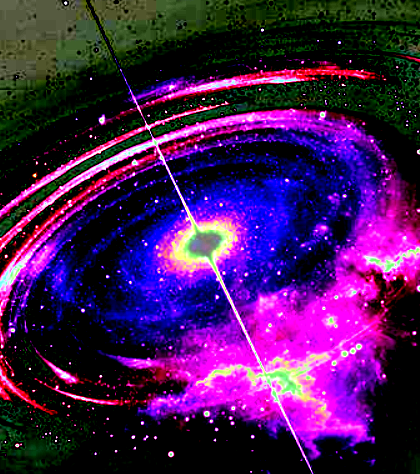Quasars aid deep view

Local experts have shed new light on the state of the early universe by measuring the density of carbon in the gases surrounding ancient galaxies.
The study adds another piece to the puzzle of the history of the universe. It shows the amount of warm carbon suddenly increased by a factor of five over a period of only 300 million years - the blink of an eye in astronomical timescales.
ASTRO 3D Postdoctoral Research Associate at Swinburne University of Technology Dr Rebecca Davies is the lead author of the study.
“We found that the fraction of carbon in warm gas increased rapidly about 13 billion years ago, which may be linked to large-scale heating of gas associated with the phenomenon known as the ‘Epoch of Reionisation’,” she says.
While previous studies have suggested a rise in warm carbon, much larger samples - the basis of the new study - were needed to provide statistics to accurately measure the rate of this growth.
“That's what we've done here. And so, we present two potential interpretations of this rapid evolution,” says Dr Davies.
The first is that there is an initial increase in carbon around galaxies simply because there is more carbon in the universe.
“During the period when the first stars and galaxies are forming, a lot of heavy elements are forming because we never had carbon before we had stars,” Dr Davies says.
“And so, one possible reason for this rapid rise is just that we're seeing the products of the first generations of stars.”
However, the study also found evidence that the amount of cool carbon decreased over the same period.
This suggests that there might be two different phases in the evolution of the carbon - a rapid rise while reionisation occurs, followed by a flattening out.
The Epoch of Reionisation, which took place when the universe was “only” one billion years old, was when the lights came back on after the cosmic Dark Ages following the Big Bang.
Before this the universe was a dark, dense fog of gas. But as the first massive stars formed, their light began to shine through space and re-ionise the cosmos. This light may have led to rapid heating of the surrounding gas, causing the rise in warm carbon observed in this study.
Studies of reionisation are vital to understand when and how the first stars formed and began producing the elements that exist today, but measurements have been notoriously difficult.
During 250 hours of observations on the Very Large Telescope (VLT) at the European Southern Observatory in Chile, researchers were able to observe some of the most distant quasars, which act as flashlights, illuminating galaxies along the path from the early Universe to the Earth.
As the quasar light passes through galaxies in its 13-billion-year journey across the universe some photons are absorbed, creating distinctive barcode-like patterns in the light, which can be analysed to determine the chemical composition and temperature of gas in the galaxies.
This gives an historical picture of the development of the universe.
“These ‘barcodes’ are captured by detectors at the VLT’s X-Shooter spectrograph,” Dr Davies explains.
“This instrument splits the galaxy light into different wavelengths, like putting light through a prism, allowing us to read the barcodes and measure the properties of each galaxy.”
Astronomers are using many different types of data to build a history of the universe.
“Our results are consistent with recent studies showing that the amount of neutral hydrogen in intergalactic space decreases rapidly around the same time,” says Dr Davies.
“This research also paves the way for future investigations with the Square Kilometre Array (SKA) which aims to directly detect emission from neutral hydrogen during this key phase of the universe's history.”
The full study is accessible here.







 Print
Print